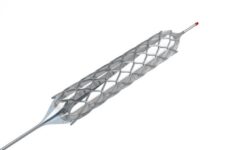Original title: Comparative effectiveness of endovascular andsurgical revascularization for patients with peripheralartery disease and critical limb ischemia: Systematicreview of revascularization in critical limb ischemia. Reference: W Schuyler Jones, et al. (Am Heart J 2014; 167:167:489-498.e7) Lower limbs critical ischemia is the most severe condition of PAD. The morbidity, mortality and costs related thereto are well documented; however, the…
Endovascular treatment in critical limb ischemia, better permeability with similar mortality and amputation than surgery.
Original title: Comparative effectiveness of endovascular and surgical revascularization for patients with peripheral artery disease and critical limb ischemia. Reference: W. Schuyler Jones et al. American Heart Journal 2014. Epub ahead of print. Critical limb ischemia is the most severe condition affecting patients with peripheral vascular disease. Mortality, morbidity, and costs associated with this condition are…
The ball drug is effective in the femoropopliteal area
Original title: Drug-Eluting Balloon in Peripheral Intervention for the Superficial Femoral Artery. The DEBATE-SFA Randomized Trial (Drug Eluting Balloon in Peripheral Intervention for Superficial Femoral Artery). Reference: Liistro, F, el tal. J Am Coll Cardiol Intv 2013;6(12):1295-1302 The current treatment of choice in the femoropopliteal area is angioplasty, however, this procedure has a high rate of restenosis…
Amputation, one of worse prognostic variables
Original title: Lower Extremity Amputation: Factors Associated With Mortality or Contralateral Amputation Reference: Samir K. Shah, et; al. Vascular and Endovascular Surgery 2013:47 (8):608-613. Peripheral vascular disease is associated with trophic injuries with tissue lose, often leading to amputation, of which about 50 % were major amputations. 454 amputations in 391 patients were analyzed, 63 were contralateral. Most…
Sub intimal recanalization of superficial femoral , femoropopliteal bypass similar results
Original title: Subintimal Recanalization Plus Stenting or Bypass for Management of Claudicants with Femoro-popliteal Occlusions. Reference: Boufi et al. Eur J Vasc Endovasc Surg. Volume 46 Issue 3 September/2013. The main criticism of sub intimal technique is its relative low permeability compared to the surgical technique . Different studies reported a permeability between 56 and 70 % annually .…
Result of bifurcated devices to protect the internal iliac in aorto-iliac aneurysms
Original title: Endovascular Treatment of Aorto-iliac Aneurysms: Four-year Results of Iliac Branch Endograft. Reference: G. Pratesi et al. Eur J Vasc Endovasc Surg. 2013 Jun;45(6):607-9. Iliac bifurcated devices have proven to be effective in treating common iliac aneurysms but the findings are based on small series, generally from a sole center experience. This multicenter registry included 85 patients…
Endovascular or surgical popliteal aneurysms exclusion – both with good results but for different patients.
Original title: A Multicentric Experience with Open Surgical Repair and Endovascular Exclusion of Popliteal Artery Aneurysms. Reference: R. Pulli et al. European Journal of Vascular and Endovascular Surgery, Volume 45, Issue 4, Pages 357-363. Complications of a popliteal aneurysm may cause rupture, distal embolization or thrombosis with a risk of any of them affecting the lower limb.…
Angioplasty to common femoral artery begins to emerge as an alternative to surgery
Original title: Acute and Medium-Term Outcomes of Endovascular Therapy of Obstructive Disease of Diverse Etiology of the Common Femoral Artery. Reference: Philip B. Dattilo et al. Catheterization and Cardiovascular Interventions 81:1013–1022 (2013). Surgical endarterectomy is established as the gold standard for treating injuries to common femoral artery since angioplasty presents some difficulties due to the risk of compromising…
Safety and superior effectiveness over two years in femoropopliteal region with drug-eluting stents
Original title: Sustained safety and effectiveness of paclitaxel-eluting stents for femoropopliteal lesions: two-year follow-up from the Zilver PTX randomized and single-arm clinical studies. Reference: Michael D. Dake et al. J Am Coll Cardiol 2013. Article in press. Studies with long-term monitoring showed mainly the limited permeability of balloon angioplasty, especially over challenging injuries such as total occlusions or…
More evidence for drug eluting balloons in the femoropopliteal region
Original title: 2-Year Results of Paclitaxel-Eluting Balloons for Femoropopliteal Artery Disease. Evidence From a Multicenter Registry. Reference: Antonio Micari et al. J Am Coll Cardiol Intv 2013;6:282–9. Paclitaxel-eluting balloons appear safe and effective for treating atherosclerotic lesions in the femoropopliteal region, leaving the stent only as a rescue strategy against a suboptimal outcome. However, the vast majority of…
The largest series of femoropopliteal in-stent restenosis to date
Original title: Treatment of Femoropopliteal In-Stent Restenosis With Paclitaxel-Eluting Stents. Zilver PTX Global Registry. ZILVER-PTX. Reference: Thomas Zeller et al. J Am Coll Cardiol Intv 2013;6:274–81. Femoropopliteal in-stent restenosis (ISR) is reported in between 19% and 37% of lesions a year and this incidence increases with lesion length. The ZILVER-PTX study tested the self-expanding paclitaxel-eluting nitinol stent (Cook…










